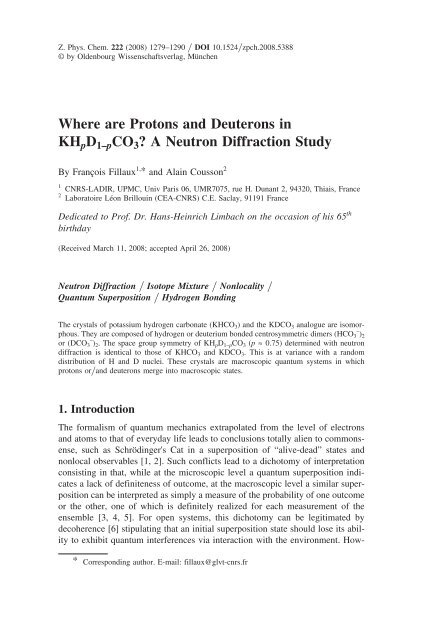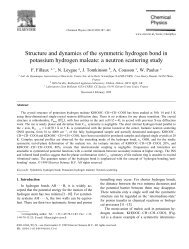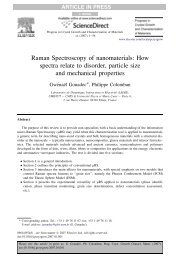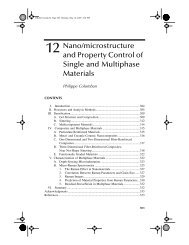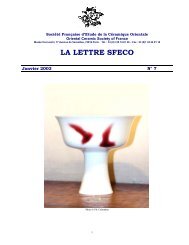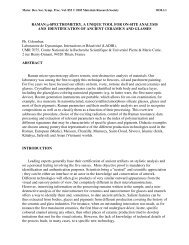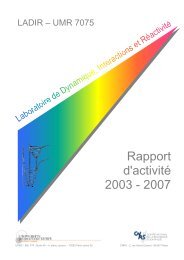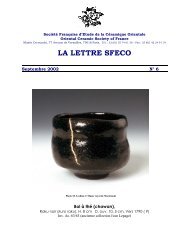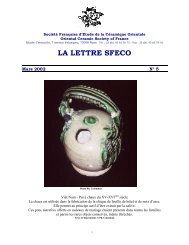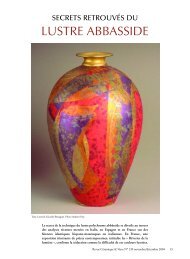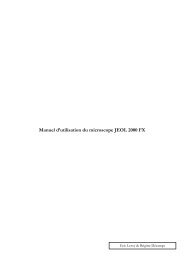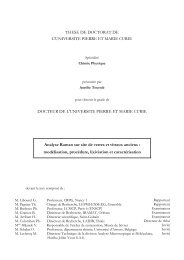Where are Protons and Deuterons in KHpD1âpCO3? A Neutron ...
Where are Protons and Deuterons in KHpD1âpCO3? A Neutron ...
Where are Protons and Deuterons in KHpD1âpCO3? A Neutron ...
Create successful ePaper yourself
Turn your PDF publications into a flip-book with our unique Google optimized e-Paper software.
Z. Phys. Chem. 222 (2008) 1279–1290 . DOI 10.1524.zpch.2008.5388<br />
© by Oldenbourg Wissenschaftsverlag, München<br />
<strong>Where</strong> <strong>are</strong> <strong>Protons</strong> <strong>and</strong> <strong>Deuterons</strong> <strong>in</strong><br />
KH p D 1–p CO 3 A <strong>Neutron</strong> Diffraction Study<br />
By François Fillaux 1, * <strong>and</strong> Ala<strong>in</strong> Cousson 2<br />
1 CNRS-LADIR, UPMC, Univ Paris 06, UMR7075, rue H. Dunant 2, 94320, Thiais, France<br />
2 Laboratoire Léon Brillou<strong>in</strong> (CEA-CNRS) C.E. Saclay, 91191 France<br />
Dedicated to Prof. Dr. Hans-He<strong>in</strong>rich Limbach on the occasion of his 65 th<br />
birthday<br />
(Received March 11, 2008; accepted April 26, 2008)<br />
<strong>Neutron</strong> Diffraction . Isotope Mixture . Nonlocality .<br />
Quantum Superposition . Hydrogen Bond<strong>in</strong>g<br />
The crystals of potassium hydrogen carbonate (KHCO 3 ) <strong>and</strong> the KDCO 3 analogue <strong>are</strong> isomorphous.<br />
They <strong>are</strong> composed of hydrogen or deuterium bonded centrosymmetric dimers (HCO 3 – ) 2<br />
or (DCO 3 – ) 2 . The space group symmetry of KH p D 1–p CO 3 (p ≈ 0.75) determ<strong>in</strong>ed with neutron<br />
diffraction is identical to those of KHCO 3 <strong>and</strong> KDCO 3 . This is at variance with a r<strong>and</strong>om<br />
distribution of H <strong>and</strong> D nuclei. These crystals <strong>are</strong> macroscopic quantum systems <strong>in</strong> which<br />
protons or.<strong>and</strong> deuterons merge <strong>in</strong>to macroscopic states.<br />
1. Introduction<br />
The formalism of quantum mechanics extrapolated from the level of electrons<br />
<strong>and</strong> atoms to that of everyday life leads to conclusions totally alien to commonsense,<br />
such as Schröd<strong>in</strong>ger's Cat <strong>in</strong> a superposition of “alive-dead” states <strong>and</strong><br />
nonlocal observables [1, 2]. Such conflicts lead to a dichotomy of <strong>in</strong>terpretation<br />
consist<strong>in</strong>g <strong>in</strong> that, while at the microscopic level a quantum superposition <strong>in</strong>dicates<br />
a lack of def<strong>in</strong>iteness of outcome, at the macroscopic level a similar superposition<br />
can be <strong>in</strong>terpreted as simply a measure of the probability of one outcome<br />
or the other, one of which is def<strong>in</strong>itely realized for each measurement of the<br />
ensemble [3, 4, 5]. For open systems, this dichotomy can be legitimated by<br />
decoherence [6] stipulat<strong>in</strong>g that an <strong>in</strong>itial superposition state should lose its ability<br />
to exhibit quantum <strong>in</strong>terferences via <strong>in</strong>teraction with the environment. How-<br />
* Correspond<strong>in</strong>g author. E-mail: fillaux@glvt-cnrs.fr
1280 F. Fillaux <strong>and</strong> A. Cousson<br />
ever, s<strong>in</strong>ce the quantum theory does not predict any def<strong>in</strong>ite divid<strong>in</strong>g l<strong>in</strong>e between<br />
quantal <strong>and</strong> classical regimes, macroscopic quantum behaviour is possible<br />
for systems decoupled from, or very weakly coupled to, the surround<strong>in</strong>gs [7]. In<br />
pr<strong>in</strong>ciple, there is no upper limit <strong>in</strong> size, complexity, <strong>and</strong> temperature, beyond<br />
which such systems should be doomed to classicality.<br />
As a matter of fact, defect-free crystals <strong>are</strong> macroscopic quantum systems<br />
with discrete phonon states at any temperature below melt<strong>in</strong>g or decomposition.<br />
This is an unavoidable consequence of the translational <strong>in</strong>variance of the lattice.<br />
Yet, the dichotomy of <strong>in</strong>terpretation arises for O-H…O hydrogen bonds, when<br />
the coexistence of two configurations, say O1–H…O2 <strong>and</strong> O1…H–O2, is conceived<br />
of as “disorder” [8]. <strong>Protons</strong> <strong>are</strong> thought of as dimensionless particles,<br />
with def<strong>in</strong>ite positions <strong>and</strong> momenta, mov<strong>in</strong>g <strong>in</strong> a double-well coupled to an<br />
<strong>in</strong>coherent thermal bath. By contrast, vibrational spectra provide unquestionable<br />
evidences of phonon states show<strong>in</strong>g that the translational <strong>in</strong>variance <strong>and</strong> the<br />
quantum nature of lattice dynamics <strong>are</strong> not destroyed by proton transfer. It is<br />
therefore compulsory to elaborate a purely quantum rationale avoid<strong>in</strong>g any classical<br />
<strong>in</strong>gredient [9].<br />
Such a theoretical framework has been elaborated for the crystal of potassium<br />
hydrogen carbonate (KHCO 3 ) made of hydrogen bonded centrosymmetric dimers<br />
(HCO 3 – ) 2 separated by K + entities [10, 11]. The coexistence of two configurations<br />
for protons was first regarded as statistical <strong>in</strong> nature [12, 13]. However,<br />
vibrational spectra (<strong>in</strong>fr<strong>are</strong>d, Raman, <strong>in</strong>elastic neutron scatter<strong>in</strong>g-INS) <strong>and</strong> neutron<br />
diffraction evidence the macroscopic quantum behaviour of protons <strong>and</strong><br />
theoretical arguments suggest that this behaviour is <strong>in</strong>tr<strong>in</strong>sic to the crystal state<br />
[14, 15, 16, 17, 18].<br />
In the present paper, we exam<strong>in</strong>e whether macroscopic states survive <strong>in</strong> a<br />
mixed crystal KH p D 1–p CO 3 , grown from a water solution composed of H 2 O,<br />
HDO, D 2 O molecules. S<strong>in</strong>ce there is no segregation of H <strong>and</strong> D atoms <strong>in</strong>to<br />
separate doma<strong>in</strong>s or clusters, it might seem straightforward to suppose that the<br />
crystal is a mixture of HH, HD, DD dimers, with probabilities p 2 ,2p(1–p), (1–p) 2 ,<br />
respectively [19, 20]. A r<strong>and</strong>om distribution of such dimers should destroy the<br />
translational <strong>in</strong>variance of the crystal, as well as – needless to say – the space<br />
group symmetry, <strong>and</strong> this should be evidenced by neutron diffraction.<br />
We report below neutron diffraction measurements show<strong>in</strong>g that a mixed<br />
crystal (p ≈ 0.75) is isomorphous to the pure analogues KHCO 3 <strong>and</strong> KDCO 3 .<br />
This is at variance with any r<strong>and</strong>om distribution of H <strong>and</strong> D nuclei, so the<br />
concept of macroscopic states previously elaborated for pure crystals should hold<br />
for isotope mixtures, as well.<br />
The organization of this paper is as follows. The crystal structure of KHCO 3<br />
at 300 K is presented <strong>in</strong> Sec. 2 <strong>and</strong> the theoretical framework for H or D macroscopic<br />
states is presented <strong>in</strong> Sec. 3. In Sec. 4 we present evidences of macroscopic<br />
proton states obta<strong>in</strong>ed with neutron diffraction. F<strong>in</strong>ally, some consequences<br />
of the P2 1 .a space group symmetry determ<strong>in</strong>ed with neutron diffraction for<br />
the mixed crystal <strong>are</strong> discussed <strong>in</strong> Sec. 5.
<strong>Where</strong> <strong>are</strong> <strong>Protons</strong> <strong>and</strong> <strong>Deuterons</strong> <strong>in</strong> KH p D 1–p CO 3 … 1281<br />
Fig. 1. Schematic view of the crystall<strong>in</strong>e structure of KHCO 3 at 300 K. The arrows po<strong>in</strong>t to<br />
the sites occupied at low temperature. Dashed l<strong>in</strong>es through protons <strong>are</strong> guides for the eyes.<br />
The ellipsoids represent 50% of the probability density for nuclei.<br />
2. The crystal structure of KHCO 3 <strong>and</strong> KDCO 3<br />
The crystal of KHCO 3 is monocl<strong>in</strong>ic, space group P2 1 .a (C 2h 5 ), with four equivalent<br />
entities per unit cell (Fig. 1). Centrosymmetric dimers (HCO 3 – ) 2 l<strong>in</strong>ked by<br />
moderately strong hydrogen bonds, with lengths R OO ≈ 2.58 Å, <strong>are</strong> well separated<br />
by K + ions. All dimers lie practically <strong>in</strong> (103) planes, hydrogen bonds <strong>are</strong><br />
virtually parallel to each other, <strong>and</strong> all protons <strong>are</strong> crystallographically equivalent<br />
(<strong>in</strong>dist<strong>in</strong>guishable). This crystal structure is unique to prob<strong>in</strong>g proton dynamics<br />
along directions x, y, z, parallel to the stretch<strong>in</strong>g (νOH), the <strong>in</strong>-plane bend<strong>in</strong>g<br />
(δOH), <strong>and</strong> the out-of-plane bend<strong>in</strong>g (γOH) coord<strong>in</strong>ates, respectively.<br />
From 14 K to 300 K, there is no structural phase transition. The <strong>in</strong>crease of<br />
the unit cell dimensions <strong>and</strong> of the hydrogen bond length <strong>are</strong> marg<strong>in</strong>al. Only the<br />
population of proton sites changes significantly. Below ≈ 150 K, all dimers <strong>are</strong><br />
<strong>in</strong> a unique configuration, say L (see arrows <strong>in</strong> Fig. 1). At elevated temperatures,<br />
protons <strong>are</strong> progressively transferred along the hydrogen bonds to less favored<br />
sites (configuration R)at≈ 0.6 Å from the ma<strong>in</strong> position. The center of symmetry<br />
is preserved <strong>and</strong> all proton sites rema<strong>in</strong> <strong>in</strong>dist<strong>in</strong>guishable. The population of the<br />
less favored site (or <strong>in</strong>terconversion degree r ≈ 0.22) is determ<strong>in</strong>ed by an asymmetric<br />
double-well [21, 22], but there <strong>are</strong> controversies as to whether this leads<br />
to statistical disorder [12, 13] or quantum delocalization [17, 18, 23, 9].<br />
The isomorphous P2 1 .a crystal of KDCO 3 is made of a very similar arrangement<br />
of centrosymmetric dimers. The hydrogen bond length is slightly longer<br />
(R OO ≈ 2.61 Å) <strong>and</strong> the population of the less favored site is smaller (r ≈ 0.12)
1282 F. Fillaux <strong>and</strong> A. Cousson<br />
[11]. This suggests a slightly greater potential asymmetry for KDCO 3 than for<br />
KHCO 3 [21].<br />
3. Theory<br />
In this section we present the bases of the theoretical framework lead<strong>in</strong>g to<br />
macroscopic states for protons or deuterons [17, 18].<br />
3.1 The adiabatic separation<br />
With<strong>in</strong> the framework of the Born-Oppenheimer approximation, the vibrational<br />
Hamiltonian can be partitioned as<br />
(1)<br />
where H H.D <strong>and</strong> H at represent the sublattices of light nuclei (H + or D + ) <strong>and</strong><br />
heavy atoms, respectively, while C (H.D)at couples the subsystems. For OHO or<br />
ODO bonds, coupl<strong>in</strong>g terms between OH.OD <strong>and</strong> O…O degrees of freedom <strong>are</strong><br />
rather large [8, 24], hence beyond the framework of the perturbation theory. Two<br />
approaches, either semiclassical or quantum, <strong>are</strong> envisaged.<br />
Semiclassical protons or deuterons <strong>are</strong> dimensionless particles mov<strong>in</strong>g across<br />
a potential hypersurface [25, 26, 27, 28, 29]. Complex trajectories <strong>in</strong>volv<strong>in</strong>g<br />
heavy atom coord<strong>in</strong>ates lead to mass renormalization, <strong>and</strong> to <strong>in</strong>coherent phononassisted<br />
tunnell<strong>in</strong>g [12, 13, 30]. This approach is quite natural when the Born-<br />
Oppenheimer surface is known, but quantum effects can be severely underestimated.<br />
Alternatively, if the classical concept of “trajectory”, totally alien to quantum<br />
mechanics, is ab<strong>and</strong>oned, adiabatic separation of the two subsystems, namely<br />
H H.D <strong>and</strong> H at , may lead to tractable models [8, 17, 27, 31, 32, 33]. Then,<br />
protons or deuterons <strong>in</strong> a def<strong>in</strong>ite eigen state should rema<strong>in</strong> <strong>in</strong> the same state <strong>in</strong><br />
the course of time, while heavy atoms oscillate slowly, <strong>in</strong> an adiabatic hyperpotential<br />
depend<strong>in</strong>g on the proton.deuteron state, through the coupl<strong>in</strong>g term. This<br />
separation is relevant for KHCO 3 <strong>and</strong> KDCO 3 because adiabatic potentials for<br />
different proton or deuteron states do not <strong>in</strong>tersect each other. In fact, the separation<br />
is rigorously exact <strong>in</strong> the ground state, s<strong>in</strong>ce protons or deuterons should<br />
rema<strong>in</strong> <strong>in</strong> this state for ever, if there is no external perturbation. Then, protons<br />
<strong>are</strong> b<strong>are</strong> fermions, while deuterons <strong>are</strong> bosons, so quantum correlations should<br />
be different for the two crystals.<br />
3.2 Macroscopic states<br />
Consider a crystal composed of very large numbers N a , N b , N c (N = N a N b N c )of<br />
unit cells labelled j, k, l, along crystal axes (a), (b), (c), respectively. The two<br />
dimers per unit cell <strong>are</strong> <strong>in</strong>dexed as j, k, l <strong>and</strong> j', k, l, respectively, with j = j'. For<br />
centrosymmetric dimers, there is no permanent dipolar <strong>in</strong>teraction, so <strong>in</strong>terdimer
<strong>Where</strong> <strong>are</strong> <strong>Protons</strong> <strong>and</strong> <strong>Deuterons</strong> <strong>in</strong> KH p D 1–p CO 3 … 1283<br />
coupl<strong>in</strong>g terms <strong>and</strong> phonon dispersion <strong>are</strong> negligible [22, 34, 35]. The eigen<br />
states of the sublattice of protons can be therefore represented <strong>in</strong> a rather simple<br />
way with the basis sets of eigen states for isolated dimers<br />
A dimer (H1, H2) or (D1, D2) is modelled with coupled centrosymmetric<br />
coll<strong>in</strong>ear oscillators <strong>in</strong> three dimensions, along coord<strong>in</strong>ates {α 1jkl } <strong>and</strong> {α 2jkl }<br />
(α = x, y, z). The center of symmetry is at {α 0jkl }. The mass-conserv<strong>in</strong>g symmetry<br />
coord<strong>in</strong>ates <strong>in</strong>dependent of j, k, l, <strong>and</strong> their conjugated momenta,<br />
(2)<br />
lead to uncoupled oscillators at frequencies h – ω sα <strong>and</strong> h – ω aα , respectively, each<br />
with m = 1 amu. The difference (h – ω sα – h – ω aα ) depends on the coupl<strong>in</strong>g term<br />
(say λ α ). The wave functions, {Ψ njkl a (α a )}, {Ψ n'jkl s (α s –√2α 0 )}, cannot be factored<br />
<strong>in</strong>to wave functions for <strong>in</strong>dividual particles, so there is no local <strong>in</strong>formation<br />
available for these entangled oscillators. Then, the wave functions of protons<br />
(fermions) or deuterons (bosons) <strong>are</strong> subject to the symmetrization postulate of<br />
quantum mechanics [36].<br />
3.2.1 <strong>Protons</strong><br />
The degenerate ground state of <strong>in</strong>dist<strong>in</strong>guishable fermions must be antisymmetrized<br />
with respect to site permutation. For this purpose, the wave function is<br />
written as a l<strong>in</strong>ear comb<strong>in</strong>ation<br />
<strong>and</strong> the antisymmetrized state vectors with s<strong>in</strong>glet-like - S * or triplet-like - T *<br />
sp<strong>in</strong> symmetry <strong>are</strong>:<br />
(3)<br />
(4)<br />
The oscillators <strong>are</strong> now entangled <strong>in</strong> position, momentum, <strong>and</strong> sp<strong>in</strong>. In contrast<br />
to magnetic systems [37], there is no level splitt<strong>in</strong>g, so the symmetry related<br />
entanglement is energy-free. It is also <strong>in</strong>dependent of λ α . Furthermore, as there<br />
is no significant exchange <strong>in</strong>tegral for protons separated by ≈ 2.2 Å [38], protons<br />
<strong>are</strong> not it<strong>in</strong>erant particles <strong>and</strong> there is no sizeable energy b<strong>and</strong> width.<br />
Consider now the whole sublattice of protons. The spatial periodicity leads<br />
to collective dynamics <strong>and</strong> nonlocal observables <strong>in</strong> three dimensions. With the<br />
vibrational wave function for the unit cell j, k, l, namely Ξ 0jklτ = Θ 0jklτ ±Θ 0j'klτ ,
1284 F. Fillaux <strong>and</strong> A. Cousson<br />
where τ = “+” or “–” for s<strong>in</strong>glet-like or triplet-like symmetry, respectively, trial<br />
phonon waves <strong>are</strong> written as<br />
where k is the wave vector, L = j a + k b + l c is the lattice vector, a, b, c, <strong>are</strong><br />
the unit cell vectors. This equation could represent collective dynamics of (H,<br />
H) dimers if they were composed bosons <strong>in</strong> a crystal made of <strong>in</strong>dist<strong>in</strong>guishable<br />
dimer entities (KHCO 3 ) 2 . However, x-ray <strong>and</strong> neutron diffraction show that the<br />
structure is composed of monomer entities (KHCO 3 ) related to each other<br />
through symmetry operations. The probability density of each atom is equally<br />
distributed over all equivalent sites <strong>and</strong>, conversely, the probability density at<br />
each site <strong>in</strong>cludes contributions from all <strong>in</strong>dist<strong>in</strong>guishable nuclei of the same<br />
k<strong>in</strong>d. Consequently, antisymmetrization applied to the sublattice of <strong>in</strong>dist<strong>in</strong>guishable<br />
fermions leads to<br />
(6)<br />
This means that there is no phonon (no elastic distortion) <strong>in</strong> the ground state.<br />
This symmetry-related “super-rigidity” [17] is totaly <strong>in</strong>dependent of any protonproton<br />
<strong>in</strong>teraction. The state vectors <strong>in</strong> three dimensions can be then written as:<br />
The wave functions Ξ 0 τ (k=0) represent collective oscillations of the superrigid<br />
lattice as a whole, with respect to the center of mass of the crystal. F<strong>in</strong>ally,<br />
the ground state of the sublattice is a superposition state as:<br />
This ground state is <strong>in</strong>tr<strong>in</strong>sically steady aga<strong>in</strong>st decoherence. Irradiation by<br />
plane waves (photons or neutrons) may s<strong>in</strong>gle out some excited states. Entanglement<br />
<strong>in</strong> position <strong>and</strong> momentum is preserved, while the sp<strong>in</strong>-symmetry <strong>and</strong> super-rigidity<br />
<strong>are</strong> destroyed. However, the sp<strong>in</strong>-symmetry reappears automatically<br />
after decay to the ground state, presumably on the time-scale of proton dynamics.<br />
Consequently, disentanglement reaches a steady regime such that the amount of<br />
transitory disentangled states is determ<strong>in</strong>ed by the ratio of density-of-states for<br />
the surround<strong>in</strong>gs (atmosphere, external radiations...) <strong>and</strong> for the crystal, respectively.<br />
This ratio is so small that disentangled states <strong>are</strong> too few to be observed.<br />
Nevertheless, they allow the super-rigid sublattice to be at thermal equilibrium<br />
with the surround<strong>in</strong>gs, despite the lack of <strong>in</strong>ternal dynamics.<br />
The ma<strong>in</strong> source of disentanglement is the thermal population of excited<br />
proton states. However, even at room temperature, the thermal population of the<br />
first excited state (< 1% for γOH ≈ 1000 cm –1 ) is of little impact to measurements.<br />
(5)<br />
(7)<br />
(8)
<strong>Where</strong> <strong>are</strong> <strong>Protons</strong> <strong>and</strong> <strong>Deuterons</strong> <strong>in</strong> KH p D 1–p CO 3 … 1285<br />
3.2.2 <strong>Deuterons</strong><br />
For the sublattice of bosons <strong>in</strong> the isomorphic crystal of KDCO 3 , Eqs (3), (4)<br />
<strong>and</strong> (6) <strong>are</strong> not relevant. There is neither sp<strong>in</strong>-symmetry nor super-rigidity. Dynamics<br />
<strong>are</strong> represented with symmetry coord<strong>in</strong>ates (2) lead<strong>in</strong>g to wave functions<br />
<strong>and</strong> phonon states<br />
(9)<br />
(10)<br />
where Ξ 0jkl± = Θ 0jkl ±Θ 0j'kl . Needless to say, the H <strong>and</strong> D nuclei have the same<br />
number of degrees of freedom (12 per unit cell), but the symmetrization postulate<br />
shr<strong>in</strong>ks the size of the allowed Hilbert space from ~12 N for bosons to ~12N for<br />
fermions.<br />
4. Prob<strong>in</strong>g quantum entanglement with neutrons<br />
<strong>Neutron</strong>s (sp<strong>in</strong> 1.2) <strong>are</strong> unique to prob<strong>in</strong>g the sp<strong>in</strong>-symmetry of macroscopic<br />
proton states (7). However, quantum entanglement is extremely fragile, as it is<br />
not stabilized by any energy. Only “non<strong>in</strong>vasive” experiments, free of measurement-<strong>in</strong>duced<br />
decoherence, <strong>are</strong> appropriate [4]. For neutron scatter<strong>in</strong>g, this<br />
means (i) no energy transfer (ii) no sp<strong>in</strong>-flip <strong>and</strong> (iii) particular values of the<br />
momentum transfer vector Q. (Q = k i – k f , where k i <strong>and</strong> k f <strong>are</strong> the <strong>in</strong>itial <strong>and</strong><br />
f<strong>in</strong>al wave vectors, respectively.)<br />
Non<strong>in</strong>vasive diffraction events preserv<strong>in</strong>g the super-rigidity occur when components<br />
of the momentum transfer along proton coord<strong>in</strong>ates (Q x , Q y , Q z ) match<br />
a node of the reciprocal sublattice of protons, so the momentum transfer is the<br />
same at all sites. Then, neutrons probe super-rigid states without any <strong>in</strong>duced<br />
distortion. The only <strong>in</strong>formation conveyed by such events is the perfect periodicity<br />
of the sublattice, so the Debye-Waller factor is equal to unity at any temperature.<br />
In addition, thanks to the sp<strong>in</strong>-symmetry, the scattered <strong>in</strong>tensity is proportional<br />
to the total cross-section σ H ≈ 82.0 b [17, 39]. Otherwise, if the match<strong>in</strong>g<br />
condition is not realized, (i) the sp<strong>in</strong>-symmetry is destroyed, (ii) the <strong>in</strong>tensity<br />
scattered by protons is proportional to the coherent cross-section σ Hc ≈ 1.76 b,<br />
(iii) Bragg-peaks <strong>are</strong> depressed by the usual Debye-Waller factor for non-rigid<br />
lattices. Quantum correlations can be therefore clearly observed, thanks to the<br />
dramatic enhancement factor σ H . σ Hc ≈ 45. Furthermore, the <strong>in</strong>tensity scattered<br />
by heavy atoms, proportional to σ cKCO3 ≈ 27.7 b, is depressed by the Debye-<br />
Waller factor: exp –2W KCO3 (Q). Therefore, the contribution at large Q-values is<br />
much weaker than that of the entangled sublattice <strong>and</strong> the contrast of <strong>in</strong>tensity<br />
is enhanced at elevated temperatures.
1286 F. Fillaux <strong>and</strong> A. Cousson<br />
Fig. 2. Diffraction patterns of KHCO 3 at 30 K (top) <strong>and</strong> 300 K (bottom) <strong>in</strong> the (a * , c * ) reciprocal<br />
plane at k = 0, after Ref. [17]. The arrows emphasize ridges of <strong>in</strong>tensity parallel to Q z <strong>and</strong><br />
perpendicular to the dimer plane (dash l<strong>in</strong>es along Q x ).<br />
The dashed l<strong>in</strong>es <strong>in</strong> Fig. 1 show that proton sites <strong>are</strong> aligned along x <strong>and</strong> y,<br />
but not along z. Consequently, the non<strong>in</strong>vasive condition can be realized for Q x<br />
<strong>and</strong> Q y , whereas Q z does not co<strong>in</strong>cide, strictly speak<strong>in</strong>g, with a nod of the reciprocal<br />
lattice of protons. The diffraction pattern is composed of rods of diffuse<br />
scatter<strong>in</strong>g parallel to Q z , cigar-like shaped by the Debye-Waller factor. A detailed<br />
analysis of the scatter<strong>in</strong>g function reveals a complex pattern of rods of <strong>in</strong>tensity,<br />
<strong>in</strong> full agreement with observations [17, 18]. For example, Fig. 2 shows slices<br />
of the diffraction patterns of KHCO 3 at 30 <strong>and</strong> 300 K, <strong>in</strong> the (a * , c * ) reciprocal<br />
plane, at Q y = 0 (k = Q y .b * = 0). The cigar-like shaped rods <strong>are</strong> observed at<br />
Q x = 0 <strong>and</strong> ±(10.00 ±0.25) Å –1 , <strong>in</strong> accordance with the distance of ≈ 0.6 Å<br />
between double l<strong>in</strong>es of proton. These rods <strong>are</strong> evidences of macroscopic quan-
<strong>Where</strong> <strong>are</strong> <strong>Protons</strong> <strong>and</strong> <strong>Deuterons</strong> <strong>in</strong> KH p D 1–p CO 3 … 1287<br />
Fig. 3. Projections on the (a, b) plane of the L (bottom) <strong>and</strong> R (top) configurations.<br />
tum correlations <strong>in</strong> the sublattice of protons. As anticipated from (10), these rods<br />
<strong>are</strong> not observed for KDCO 3 [16].<br />
At low temperatures, the rods <strong>are</strong> partially hidden by the anisotropic cont<strong>in</strong>uum,<br />
centered at Q = 0, due to <strong>in</strong>coherent scatter<strong>in</strong>g. At 300 K, this cont<strong>in</strong>uum<br />
is dramatically depressed by the Debye-Waller factor, while diffraction by the<br />
super-rigid sublattice is largely unaffected. Quite remarkably, quantum correlations<br />
<strong>are</strong> not destroyed by <strong>in</strong>terconversion. The sublattice is therefore a superposition<br />
of macroscopic states, - L * <strong>and</strong> - R *, correspond<strong>in</strong>g to the structures<br />
sketched <strong>in</strong> Fig. 3.<br />
Theory <strong>and</strong> experiments show that protons (deuterons) <strong>in</strong> the crystal field <strong>are</strong><br />
not <strong>in</strong>dividual particles possess<strong>in</strong>g properties <strong>in</strong> their own rights. Instead of that,<br />
they merge <strong>in</strong>to macroscopic states. The theory suggests that such matter fields,<br />
<strong>in</strong>tr<strong>in</strong>sic to translational <strong>in</strong>variance, should occur <strong>in</strong> many crystals. However, the<br />
diffraction patterns <strong>in</strong> Fig. 2 <strong>are</strong> easy to <strong>in</strong>terpret because protons <strong>are</strong> <strong>in</strong>dist<strong>in</strong>guishable<br />
<strong>and</strong> hydrogen bonds <strong>are</strong> aligned (Fig. 1). For more complex structures,<br />
seek<strong>in</strong>g rods of diffuse scatter<strong>in</strong>g <strong>in</strong> diffraction patterns could be problematic. In<br />
the next section, we propose a complementary approach to evidence the nonlocal<br />
nature of protons <strong>and</strong> deuterons.<br />
5. Isotope mixtures<br />
In the present section we exam<strong>in</strong>e whether macroscopic states exist <strong>in</strong> isotope<br />
mixtures KH p D 1–p CO 3 . We anticipate that any superposition of (7) <strong>and</strong> (10)<br />
should preserve the P2 1 .a space group symmetry of the crystal, whereas any
1288 F. Fillaux <strong>and</strong> A. Cousson<br />
Table 1. Unit cell parameters <strong>in</strong> Å <strong>and</strong> ° units determ<strong>in</strong>ed with s<strong>in</strong>gle-crystal neutron diffraction<br />
at 300 K. λ = 0.8305 Å, space group P 2 1 .a. The variance for the last digit is given <strong>in</strong><br />
p<strong>are</strong>ntheses.<br />
KH 0.75 D 0.25 CO 3 KHCO 3 [17]<br />
a(Å) 15.180(1) 15.180(1)<br />
b(Å) 5.620(1) 5.620(4)<br />
c(Å) 3.710(1) 3.710(4)<br />
β 104.67(1) ° 104.67(5) °<br />
statistical distribution of isotopes, here or there, should destroy the translational<br />
<strong>in</strong>variance. Because neutrons <strong>are</strong> scattered by nuclei, the diffraction pattern<br />
should discrim<strong>in</strong>ate between these two possibilities. By contrast, the P2 1 .a symmetry<br />
evidenced by x-ray would not exclude, per se, a r<strong>and</strong>om distribution of<br />
isotopes, for they have identical electronic structures.<br />
A nearly cubic specimen (3!3!3 mm 3 ) was cut from a large crystal grown<br />
by cool<strong>in</strong>g slowly a saturated solution <strong>in</strong> a mixture of H 2 O(≈ 75%) <strong>and</strong> D 2 O(≈<br />
25%). Measurements were conducted with the four-circle diffractometer 5C2 at<br />
the Orphée reactor (Laboratoire Léon-Brillou<strong>in</strong>) [40]. The crystal wrapped <strong>in</strong><br />
alum<strong>in</strong>um was ma<strong>in</strong>ta<strong>in</strong>ed at (300 ±1) K. Data reduction was carried out with<br />
CRYSTALS [41, 42].<br />
A prelim<strong>in</strong>ary <strong>in</strong>spection of <strong>in</strong>tensities at the absent reflections (0k0 for k ≠<br />
2n <strong>and</strong> h0l for h ≠ 2n) confirms the P2 1 .a space group assignment. The unit cell<br />
parameters <strong>in</strong> Table 1 <strong>are</strong> identical to those of KHCO 3 . A complete determ<strong>in</strong>ation<br />
of the positional <strong>and</strong> thermal parameters is currently <strong>in</strong> progress.<br />
The P2 1 .a symmetry is at variance with a distribution of H <strong>and</strong> D nuclei at<br />
r<strong>and</strong>om. It is consistent with the existence of four sublattices, H L ,H R ,D L ,D R ,<br />
analogous to those sketched <strong>in</strong> Fig. 3, such as:<br />
(11)<br />
With a diffractometer based at a reactor source one measures a limited range<br />
of the reciprocal space, typically - Q - ( 5Å –1 . The match<strong>in</strong>g condition for<br />
non<strong>in</strong>vasive measurements is realized only at Q x = Q y = 0, so for almost all<br />
measured Bragg-peaks, the sp<strong>in</strong> symmetry is destroyed, the cross-section is σ Hc ,<br />
<strong>and</strong> the sublattice of protons behaves exactly the same as a non-rigid lattice of<br />
bosons (10). The four sublattices <strong>are</strong> therefore consistent with a superposition of<br />
separable macroscopic states such as: - H k± * L , - H k± * R , - D k± * L , - D k± * R . There<br />
is no direct <strong>in</strong>formation as to whether quantum correlations for proton states hold<br />
<strong>in</strong> the mixed sublattice. This po<strong>in</strong>t deserves further <strong>in</strong>vestigations.
<strong>Where</strong> <strong>are</strong> <strong>Protons</strong> <strong>and</strong> <strong>Deuterons</strong> <strong>in</strong> KH p D 1–p CO 3 … 1289<br />
6 Conclusion<br />
The P2 1 .a space group symmetry of the KH p D 1–p CO 3 (p ≈ 0.75) crystal determ<strong>in</strong>ed<br />
with neutron diffraction shows that H <strong>and</strong> D nuclei <strong>are</strong> not <strong>in</strong>dividual<br />
particles located at def<strong>in</strong>ite sites <strong>and</strong> mutually exclusive. Wave-like protons <strong>and</strong><br />
deuterons <strong>are</strong> equally distributed over all <strong>in</strong>dist<strong>in</strong>guishable sites <strong>and</strong>, conversely,<br />
each site is occupied by all wave-like H <strong>and</strong> D nuclei with total occupancies p<br />
<strong>and</strong> (1–p), respectively. This nonlocal behaviour allows the sublattice H p D 1–p to<br />
match the symmetry of the electronic structure that is unaffected by isotope<br />
substitution. The superposition of macroscopic states sounds as weird as a Cat<br />
<strong>in</strong> a superposition of - alive * <strong>and</strong> - dead * states.<br />
To the question “<strong>Where</strong> <strong>are</strong> protons <strong>and</strong> deuterons”, our answer is that the<br />
particle-like representation, implicitly meant by “<strong>Where</strong>”, is irrelevant. Only the<br />
wave-like, or matter-field, representation is permitted by the crystal structure.<br />
The theory is based on fundamental pr<strong>in</strong>ciples of quantum mechanics <strong>and</strong> it is<br />
free of any ad hoc hypothesis or parameter. The nonlocal nature of protons<br />
<strong>and</strong> deuterons could be therefore of general significance. <strong>Neutron</strong> diffraction by<br />
hydrogen bonded crystals with partial isotope substitution could be a well suited<br />
<strong>and</strong> powerful approach to study nonlocal behaviors.<br />
References<br />
1. F. Laloë, Am. J. Phys. 69 (2001) 655-701.<br />
2. A. J. Leggett, J. Phys.: Condens. Matter 14 (2002) R415-R451.<br />
3. A. J. Leggett, Supplement of the progress of theoretical physics 69 (1980) 80-100.<br />
4. A. J. Leggett, A. Garg, Phys. Rev. Letters 54 (9) (1985) 857-860.<br />
5. A. J. Leggett, Rep. Prog. Phys. 71 (2008) 022001.<br />
6. W. H. Zurek, Rev. Modern Phys. 75 (3) (2003) 715-775.<br />
7. A. O. Caldeira, A. J. Leggett, Ann. Phys. 149 (1983) 374-456.<br />
8. P. Schuster, G. Zundel, C. S<strong>and</strong>orfy, The hydrogen bond. Recent developments <strong>in</strong><br />
theory <strong>and</strong> experiments. Vol. I, II <strong>and</strong> III, North-Holl<strong>and</strong> Pub. Co., Amsterdam<br />
(1976).<br />
9. F. Fillaux, J. Mol. Struct. 844-845 (2007) 308-318.<br />
10. J. O. Thomas, R. Tellgren, I. Olovsson, Acta Cryst. B 30 (1974) 1155-1166.<br />
11. J. O. Thomas, R. Tellgren, I. Olovsson, Acta Cryst. B 30 (1974) 2540-2549.<br />
12. S. Benz, U. Haeberlen, J. Tegenfeldt, J. Mag. Res. 66 (1986) 125-134.<br />
13. G. Eckold, H. Grimm, M. Ste<strong>in</strong>-Arsic, Physica B 180-181 (1992) 336-338.<br />
14. F. Fillaux, Physica D 113 (1998) 172.<br />
15. S. Ikeda, F. Fillaux, Phys. Rev. B 59 (1999) 4134-4145.<br />
16. F. Fillaux, A. Cousson, D. Keen, Phys. Rev. B 67 (2003) 054301 <strong>and</strong> 189901(E).<br />
17. F. Fillaux, A. Cousson, M. J. Gutmann, J. Phys.: Cond. Matter 18 (2006) 3229-3249.<br />
18. F. Fillaux, A. Cousson, M. J. Gutmann, J. Phys.: Cond. Matter 20 (2008) 015225.<br />
19. S. Takeda, A. Tsuzum<strong>in</strong>ati, Magn. Reson. Chem. 39 (2001) S44-S49.<br />
20. Q. Xue, A. J. Horsewill, M. R. Johnson, H. P. Trommsdorff, J. Chem. Phys. 120<br />
(23) (2004) 11107-11119.<br />
21. F. Fillaux, Chem. Phys. 74 (1983) 405-412.<br />
22. F. Fillaux, J. Tomk<strong>in</strong>son, J. Penfold, Chem. Phys. 124 (3) (1988) 425-437.<br />
23. F. Fillaux, A. Cousson, M. J. Gutmann, Pure Appl. Chem. 79 (6) (2007) 1023-1039.<br />
24. A. Novak, Struct. <strong>and</strong> Bond<strong>in</strong>g (Berl<strong>in</strong>) 18 (1974) 177-216.
1290 F. Fillaux <strong>and</strong> A. Cousson<br />
25. V. A. Benderskii, E. V. Vetoshk<strong>in</strong>, I. S. Irgibaeva, H. P. Trommsdorff, Chem. Phys.<br />
262 (2000) 393-422.<br />
26. V. A. Benderskii, E. V. Vetoshk<strong>in</strong>, H. P. Trommdorff, Chem. Phys. 271 (2001) 165-<br />
182.<br />
27. K. Giese, M. Petrovi'c, H. Naundorf, O. Kühn, Physics Reports 430 (2006) 211-276.<br />
28. Z. Smedarch<strong>in</strong>a, A. Fern<strong>and</strong>ez-Ramos, W. Siebr<strong>and</strong>, J. Chem. Phys. 122 (2005)<br />
134309.<br />
29. C. S. Tautermann, A. F. Voegele, K. R. Liedl, J. Chem. Phys. 120 (2) (2004) 631-<br />
637.<br />
30. J. L. Sk<strong>in</strong>ner, H. P. Trommsdorff, J. Chem. Phys. 89 (2) (1988) 897-907.<br />
31. F. Fillaux, F. Roma<strong>in</strong>, M.-H. Limage, N. Leygue, Phys. Chem. Chem. Phys. 8 (2006)<br />
4327 - 4336.<br />
32. A. Witkowski, J. Chem. Phys. 47 (9) (1967) 3645-3648.<br />
33. Y. Maréchal, A. Witkowski, J. Chem. Phys. 48 (8) (1968) 3697-3705.<br />
34. S. Ikeda, S. Kashida, H. Sugimoto, Y. Yamada, S. M. Benn<strong>in</strong>gton, F. Fillaux, Phys.<br />
Rev. B 66 (2002) 184302.<br />
35. S. Kashida, S. Ikeda, Y. Nakai, J. Phys. Soc. Jpn 63 (12) (1994) 4643-4647.<br />
36. C. Cohen-Tannoudji, B. Diu, F. Laloë, Mécanique Quantique. Hermann, Paris,<br />
France (1977).<br />
37. R. A. Cowley, J. Phys.: Cond. Matter 15 (2003) 4143-4152.<br />
38. F. Fillaux, A. Cousson, J. Phys.: Cond. Matter 16 (2004) 1007-1010.<br />
39. S. W. Lovesey, Nuclear scatter<strong>in</strong>g, Theory of <strong>Neutron</strong> Scattered from Condensed<br />
Matter. Vol. I, Cl<strong>are</strong>ndon Press, Oxford (1984).<br />
40. http:..www-llb.cea.fr.<br />
41. D. J. Watk<strong>in</strong>, C. K. Prout, J. R. Carruthers, P. W. Betteridge, R. I. Cooper, Crystals.<br />
Issue 11, Tech. rep., Chemical Crystallography Laboratory, University of Oxford,<br />
Engl<strong>and</strong> (1996).<br />
42. http:..www.xtl.ox.ac.uk.crystals.html.


